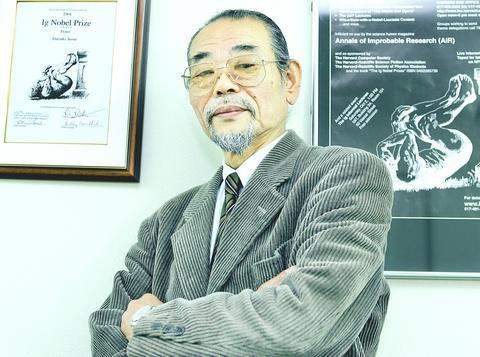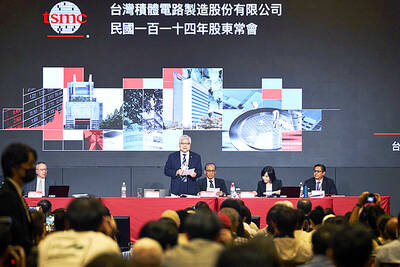Daisuke Inoue could be a billionaire if he had only filed a patent for his invention three decades ago -- the karaoke machine, which has opened up the prospect of stardom, however fleeting, to millions of musical wannabes.
Instead, the man whose creation has become a US$7.5 billion-a-year industry in Japan alone has designed gadgets to wash clothes and kill insects as he tries to put his finger on the next sensation.

PHOTO: AFP
Now aged 64, Inoue said he came up with the device that would become a worldwide social lubricant when he was a fumbling keyboardist accompanying customers at a club in the western Japanese city of Kobe.
"A driving force [for the invention] was my laziness as it was hard to master new songs one after another," Inoue told reporters in an interview.
Inoue, with a smooth deep voice, graying slicked-back hair and a ponytail, has never been able to read music even though he started earning money as a drummer when he was 16.
"Accompanying tone-deaf singers was no problem. What was toughest for me was to remember by heart several new songs every month because I couldn't read music," said the inventor of karaoke.
Inoue first got the idea for a karaoke machine in 1971 after a club customer asked him to join him on a weekend company trip as he wanted to sing to Inoue's keyboard. Inoue could not skip work at the club, so he made a tape of instrumental music for him.
Later that year, he invented the original karaoke machine, called "8 Juke," based on a car stereo and equipped with a microphone, amplifier and coin box that played music recorded on eight-track cartridge tapes. Inoue was 31 at the time.
The machine proved to be an instant hit.
Though rival devices by firms such as Daiichikosho, now the top karaoke company, appeared within three years, Inoue saw 12 good years selling tape-based karaoke machines.
His company's fortune waned with emerging laser disc-based machines in the mid-1980s. He survived by turning the company from a karaoke machine maker to a trading firm.
"I went to Daiichikosho with which we had been battling fiercely and asked them to let us handle their machines," Inoue said.
His company came to boast annual sales of ?10 billion (US$95 million). But the lifestyle proved too much for Inoue.
"It was luxury-induced depression. I had been a salesman talking directly to customers but was suddenly given a monthly salary of ?3.5 million and no real job," he said.
"I began to suffer head-aches and was unable to move to go to office," he said, recalling the months in the early 1990s he served as nominal "chairman" of the company.
He broke out of his depression by leaving the company, running around with his dogs and establishing an industry group to promote his invention, the All-Japan Karaoke Industrialist Association.
His latest invention is the "New Aqua Trio" pot which is purported to electrolyze water for washing laundry, cleaning dishes and even rinsing mouths without detergent or chemicals.
Costing ?399,000 (US$3,800), the home-use pot is touted to bring about "a cleaning revolution."
And this time, Inoue has wisely decided to patent the product, both in Japan and internationally.

CAUTIOUS RECOVERY: While the manufacturing sector returned to growth amid the US-China trade truce, firms remain wary as uncertainty clouds the outlook, the CIER said The local manufacturing sector returned to expansion last month, as the official purchasing managers’ index (PMI) rose 2.1 points to 51.0, driven by a temporary easing in US-China trade tensions, the Chung-Hua Institution for Economic Research (CIER, 中華經濟研究院) said yesterday. The PMI gauges the health of the manufacturing industry, with readings above 50 indicating expansion and those below 50 signaling contraction. “Firms are not as pessimistic as they were in April, but they remain far from optimistic,” CIER president Lien Hsien-ming (連賢明) said at a news conference. The full impact of US tariff decisions is unlikely to become clear until later this month

With an approval rating of just two percent, Peruvian President Dina Boluarte might be the world’s most unpopular leader, according to pollsters. Protests greeted her rise to power 29 months ago, and have marked her entire term — joined by assorted scandals, investigations, controversies and a surge in gang violence. The 63-year-old is the target of a dozen probes, including for her alleged failure to declare gifts of luxury jewels and watches, a scandal inevitably dubbed “Rolexgate.” She is also under the microscope for a two-week undeclared absence for nose surgery — which she insists was medical, not cosmetic — and is

GROWING CONCERN: Some senior Trump administration officials opposed the UAE expansion over fears that another TSMC project could jeopardize its US investment Taiwan Semiconductor Manufacturing Co (TSMC, 台積電) is evaluating building an advanced production facility in the United Arab Emirates (UAE) and has discussed the possibility with officials in US President Donald Trump’s administration, people familiar with the matter said, in a potentially major bet on the Middle East that would only come to fruition with Washington’s approval. The company has had multiple meetings in the past few months with US Special Envoy to the Middle East Steve Witkoff and officials from MGX, an influential investment vehicle overseen by the UAE president’s brother, the people said. The conversations are a continuation of talks that

CHIP DUTIES: TSMC said it voiced its concerns to Washington about tariffs, telling the US commerce department that it wants ‘fair treatment’ to protect its competitiveness Taiwan Semiconductor Manufacturing Co (TSMC, 台積電) yesterday reiterated robust business prospects for this year as strong artificial intelligence (AI) chip demand from Nvidia Corp and other customers would absorb the impacts of US tariffs. “The impact of tariffs would be indirect, as the custom tax is the importers’ responsibility, not the exporters,” TSMC chairman and chief executive officer C.C. Wei (魏哲家) said at the chipmaker’s annual shareholders’ meeting in Hsinchu City. TSMC’s business could be affected if people become reluctant to buy electronics due to inflated prices, Wei said. In addition, the chipmaker has voiced its concern to the US Department of Commerce